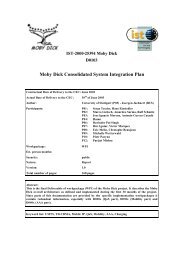IST-2000-25394 Moby Dick D0601 Dissemination and Use Plan
IST-2000-25394 Moby Dick D0601 Dissemination and Use Plan
IST-2000-25394 Moby Dick D0601 Dissemination and Use Plan
Create successful ePaper yourself
Turn your PDF publications into a flip-book with our unique Google optimized e-Paper software.
Fifth Framework Project <strong>25394</strong><br />
3 <strong>Use</strong> <strong>Plan</strong><br />
Public<br />
<strong>Dissemination</strong> <strong>and</strong> <strong>Use</strong> <strong>Plan</strong><br />
This section of the <strong>Use</strong> <strong>Plan</strong> contains the descriptions of all <strong>Moby</strong><strong>Dick</strong> partner’s plans to<br />
use the results of the project. It include business aspects as well as academic aspects. The<br />
material at this stage of Section 3.1 is based on the Technical Annex of <strong>Moby</strong><strong>Dick</strong> <strong>and</strong><br />
directly relates the use plan with the motivations the project once was driven by. The project<br />
is convinced that the market as well as technology context has not changed, there is still an<br />
emerging need for a solution on the questions posed in the Technical Annex.<br />
3.1 Opportunities<br />
The definition, implementation, <strong>and</strong> evaluation of an IPv6-based mobility-enabled end-toend<br />
QoS (Quality-of-Service) architecture starting from the IETF’s (Internet Engineering<br />
Task Force) QoS models, Mobile-IPv6 (Internet Protocol Version 6), <strong>and</strong> AAA<br />
(Authentication Authorization, <strong>and</strong> Accounting) framework, to be carried out by <strong>Moby</strong><strong>Dick</strong>,<br />
will provide a major contribution to a network technology discipline (that of Terrestrial<br />
Wireless System <strong>and</strong> Networks), which has the most profound impact on the socioeconomic<br />
situation of the general public since it involves both professional <strong>and</strong> private<br />
users. This innovative approach, covering layer 2 technology, the only layer 3 protocol of<br />
interest, IP, <strong>and</strong> example applications, is driven by trends observed at current wireless<br />
markets.<br />
Millions<br />
1,400<br />
1,200<br />
1,000<br />
800<br />
600<br />
400<br />
200<br />
More h<strong>and</strong>sets than PCs connected<br />
to the Internet by the end of 2003 !<br />
Projected PCs<br />
connected to<br />
the Internet<br />
(Dataquest 10/98)<br />
Projected<br />
cellular<br />
subscribers<br />
(Nokia 1999)<br />
Projected Web<br />
h<strong>and</strong>sets<br />
(Nokia 1999)<br />
0<br />
1996 1997 1998 1999 <strong>2000</strong> 2001 2002 2003 2004 2005<br />
Figure 2: Trends in the Device Market<br />
Considering the market opportunity, the following - nowadays typical - Figure 2 depicts the<br />
number of Internet connected h<strong>and</strong>sets or mobile hosts. This number will meet the number<br />
of fixed to the Internet connected hosts in approximately 2003. Therefore, a large potential<br />
for mobile data communication services is envisioned.<br />
At the same time more <strong>and</strong> more mobile <strong>and</strong> portable hosts will require <strong>and</strong> eventually have<br />
integrated interfaces to connect to various kinds of (access-)networks, such as cellular<br />
networks, WaveLANs <strong>and</strong> fixed, wired LANs (Local Area Network). In addition to horizontal<br />
h<strong>and</strong>over mechanisms (roaming in different cells) established in cellular networks, this<br />
multi-access network situation requires vertical (connection to different type of access<br />
Version 1.0 Page 9 of 40<br />
© Copyright 2001, the Members of the <strong>Moby</strong><strong>Dick</strong> Consortium
















